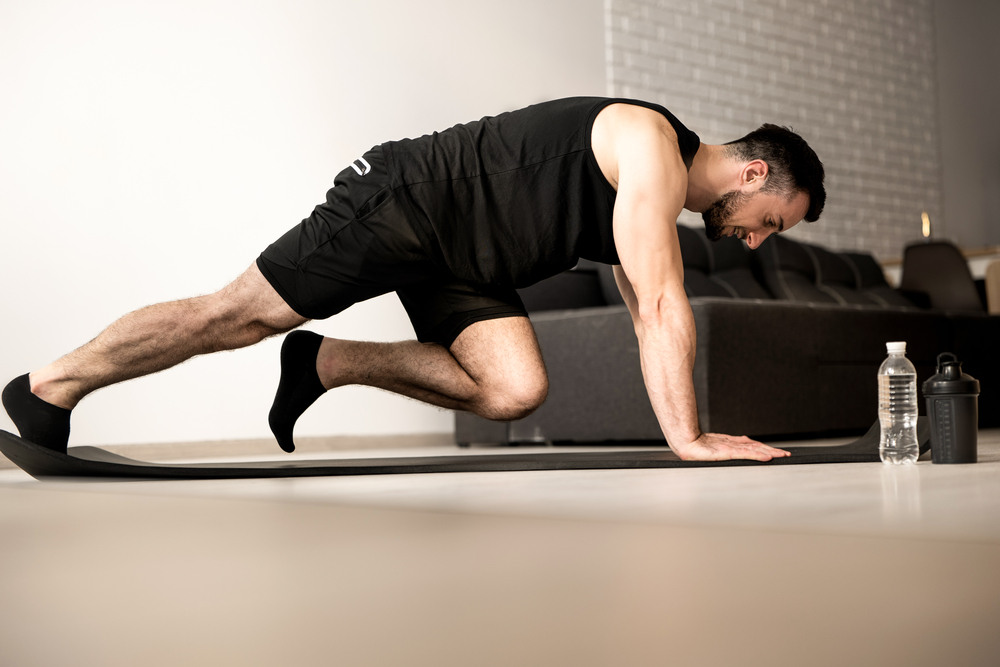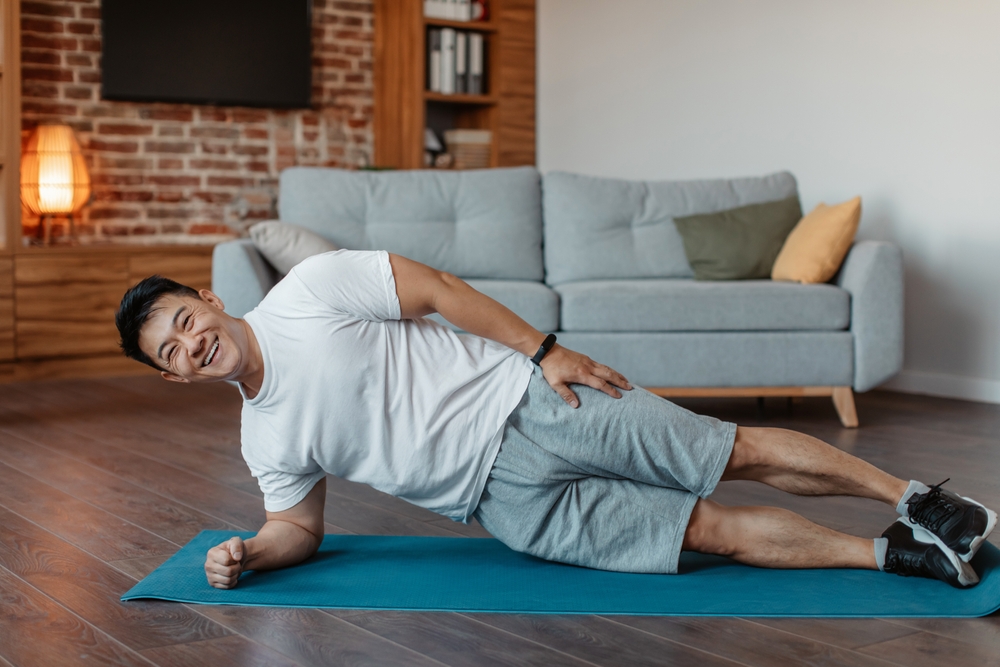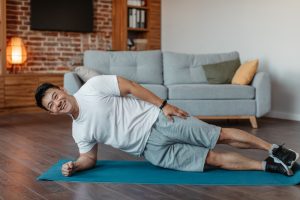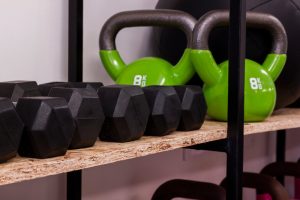Planks outperform traditional crunches for building core strength while protecting your spine from unnecessary stress.
The five most effective variations are side planks, plank with shoulder taps, reverse planks, mountain climbers, and forearm-to-full plank transitions—each targeting different muscle groups and fitness goals for comprehensive core development.
Keep reading for detailed execution instructions, scientific benefits, and training guidelines that will transform your core workout routine.
Side Plank (Forearm): Target Hidden Core Muscles
Side planks work muscles that regular planks often miss, making them incredibly valuable for building well-rounded core strength.
This variation primarily activates your glutes, obliques, and hip abductors, which are the muscles responsible for lateral stability and preventing your body from collapsing sideways during movement.
What makes side planks particularly interesting is their therapeutic potential.
Clinical research has demonstrated their effectiveness in reducing spinal curvature for patients with scoliosis, showing that this exercise offers benefits beyond just getting stronger abs.
To perform a side plank correctly, start by lying on your side with your legs straight and your hips and feet stacked on top of each other.
Position your elbow directly under your shoulder with your forearm flat against the floor.
Push your forearm into the ground to lift your torso, creating a straight line from your head down to your heels.
Proper form requires maintaining that straight alignment throughout the hold.
You should feel the work primarily in your side muscles and glutes rather than straining your neck or lower back.
Hold this position for 20 to 30 seconds, then switch to the other side.
If you're new to side planks, start with your knees on the ground instead of keeping your legs straight.
This modification reduces the load while still teaching you the proper movement pattern.
Once you can hold the basic version comfortably, you can progress to more challenging variations like raising and lowering your hips in a controlled motion.
Watch out for two common mistakes that can reduce the exercise's effectiveness.
Dropping your hips breaks the straight-line position and takes tension off the target muscles.
Rolling your shoulders forward also compromises your form and can lead to neck strain over time.
Plank with Shoulder Taps: Build Anti-Rotational Strength
When you remove one hand from your plank position, your body naturally wants to twist and rotate.
Plank with shoulder taps trains your core to resist this rotation, building what fitness professionals call anti-rotational strength.
This type of core stability translates directly to better performance in sports and everyday activities where you need to maintain your posture while moving your arms.
This dynamic variation targets multiple muscle groups simultaneously, including your hip flexors, abs, shoulders, and glutes.
The challenge comes from maintaining stability while your support base constantly changes.
Each time you lift a hand, your remaining arm and your entire core have to work harder to keep you balanced and aligned.
Start in a high plank position with your hands placed directly under your shoulders.
Your body should form a straight line from head to heels, just like a standard plank.
Keep your core tight and lift your right hand off the floor to touch your left shoulder.
Return that hand to the starting position and repeat the movement with your left hand touching your right shoulder.
The key to getting the most from this exercise lies in what doesn't move.
Your hips and shoulders should stay square to the floor throughout the entire movement, even as you're lifting and lowering your hands.
Think of your torso as a rigid plank of wood that refuses to twist or bend.
Continue alternating hands for 20 to 30 seconds, focusing on controlled and deliberate movements rather than speed.
Moving too quickly often leads to sloppy form and reduces the exercise's effectiveness.
Each tap should be purposeful, with your core working overtime to prevent any unwanted movement.
As you get stronger, you can progress this exercise in several ways.
Increasing the tempo while maintaining perfect form adds more challenge, or you can try holding the single-arm position for a few seconds before tapping your shoulder.
Both progressions will test your stability and strength in new ways.
Reverse Plank: Strengthen Your Posterior Chain
Most people spend their days hunched over computers, phones, and steering wheels, which weakens the muscles along the back of their body.
The reverse plank directly counters this problem by targeting your posterior chain—the glutes, hamstrings, shoulders, and chest muscles that help you stand tall and strong.
Research suggests this exercise can actually help improve slouching posture, making it particularly valuable in our screen-dominated world.
Unlike traditional planks that focus primarily on your front-facing muscles, the reverse plank engages often-neglected posterior muscles for more balanced development.
This creates better overall strength and helps prevent the muscle imbalances that lead to poor posture and back pain.
To set up, sit tall on the floor with your legs extended straight in front of you.
Place your hands behind your body with your fingertips pointed toward your feet.
This hand position might feel awkward at first, but it's important for proper shoulder alignment and muscle activation.
From this seated position, engage your glutes, core, and arms to lift your hips off the ground.
Push through your heels and hands to create a straight line running from your heels all the way up to your shoulders.
Your body should look like an upside-down plank, with your face pointing toward the ceiling.
The challenge is maintaining this elevated position while keeping everything aligned.
Your glutes should be working hard to keep your hips up, while your shoulder and chest muscles support your upper body weight.
Many people find this exercise surprisingly difficult because these posterior muscles aren't used to working this hard.
Hold the position for 20 to 30 seconds, or as long as you can maintain proper form.
When your hips start to sag or you can't keep the straight line anymore, it's time to lower down and rest.
If the full reverse plank proves too challenging initially, try bending your knees to reduce the load.
This modification allows you to learn the movement pattern and build strength gradually.
For those ready for more challenge, add single-leg raises while maintaining the reverse plank position, which dramatically increases the difficulty and tests your stability.
Mountain Climbers: Add Cardio to Core Training

Mountain climbers bridge the gap between strength training and cardiovascular exercise, giving you the best of both worlds in a single movement.
This exercise provides whole-body activation with particular emphasis on core endurance and stability, while the dynamic movement pattern gets your heart pumping and burns calories at a faster rate than static holds.
What sets mountain climbers apart from other plank variations is their ability to combine strength training with cardiovascular conditioning.
As you drive your knees toward your chest in rapid succession, your heart rate climbs while your core muscles work overtime to maintain stability.
This dual benefit makes mountain climbers incredibly efficient for people who want maximum results in minimum time.
Start in a high plank position with your hands placed directly under your shoulders.
Your body should form that familiar straight line from head to heels.
From here, keep your core engaged and lift your right foot off the floor, bringing your right knee toward your chest.
Return to the starting position and immediately repeat the movement with your left knee.
Continue this alternating pattern for 20 to 30 seconds, maintaining focus on your plank form throughout the entire exercise.
The temptation is to let your form break down as you get tired or try to move faster, but keeping that strong plank position is what makes this exercise so effective for core development.
Speed progression allows for increased cardiovascular benefits as you become more comfortable with the movement.
Start slowly to master the form, then gradually pick up the pace.
The faster you go, the more your heart rate climbs and the more calories you burn.
However, never sacrifice form for speed—sloppy mountain climbers with sagging hips won't give you the core benefits you're after.
The key form emphasis should be on preventing your hips from sagging during rapid movements.
As fatigue sets in, many people let their midsection drop, which reduces core activation and can strain the lower back.
Keep thinking about maintaining that rigid plank position even as your legs are moving quickly.
Mountain climbers work exceptionally well when incorporated into HIIT circuits for maximum efficiency.
You can alternate them with other exercises or use them as active recovery between more intense movements, making them a versatile addition to any workout routine.
Forearm to Full Plank Transitions: Master Dynamic Core Control
Moving between different plank positions while maintaining perfect form represents one of the most challenging tests of core stability you can perform.
Forearm to full plank transitions provide comprehensive core engagement while adding significant shoulder and arm strengthening through the dynamic movement pattern.
This exercise teaches your muscles to work together seamlessly, even as your body position constantly changes.
The beauty of this variation lies in how the dynamic movement pattern challenges your stability through position changes.
Unlike static holds where you find your balance and maintain it, transitions force your core to continuously readjust and stabilize as you move.
This translates to better functional strength for real-world activities where you need to maintain your posture while moving.
Begin in the standard forearm plank position with your elbows directly under your shoulders and your forearms flat on the ground.
From here, you'll transition to a full plank by straightening one arm at a time.
Place your right hand on the ground where your right elbow was, then do the same with your left hand, lifting yourself into the full plank position.
To return to the forearm plank, reverse the movement by slowly bending one arm at a time.
Lower your right forearm back to the ground, then your left, until you're back in the starting position.
The key is performing these transitions with slow, controlled movements to perfect the technique and maximize the challenge to your stabilizing muscles.
Core engagement becomes absolutely critical for minimizing hip swaying during position changes.
Many people let their hips rock side to side as they transition, which reduces the exercise's effectiveness and can strain the lower back.
Think of your core as a rigid cylinder that refuses to twist or bend, even as your arms are changing positions.
Aim for 30-second durations performing these transitions, completing 2 to 3 sets total.
You might find that 30 seconds feels much longer than it sounds when you're constantly moving between positions.
The continuous muscle engagement without rest makes this exercise particularly challenging.
Progressive difficulty can come through tempo variations as you get stronger.
Start with very slow, deliberate movements to master the form, then gradually increase the speed while maintaining control.
Advanced practitioners can add single-arm transitions, where you move only one arm at a time and hold each intermediate position, dramatically increasing the stability challenge.
Training Guidelines and Scientific Benefits: Maximize Your Results
Understanding the science behind plank training helps you get better results while avoiding common mistakes that waste time and effort.
Research shows that optimal hold duration ranges from 10 to 30 seconds, which might surprise people who think longer is always better.
The truth is that two-minute maximum holds show diminishing returns beyond this point—you're not getting significantly stronger, just building endurance that doesn't translate to much practical benefit.
For frequency, three sessions per week provides maximum gains without overtraining your core muscles.
This gives your body enough stimulus to adapt and grow stronger while allowing adequate recovery between sessions.
Interestingly, if you're looking to optimize athletic performance improvements, repeated 10-second holds may actually work better than longer durations, as this approach seems to build the type of explosive core strength that transfers to sports and dynamic activities.
One of the most compelling reasons to choose planks over traditional crunches comes from biomechanical research.
Planks create low compressive forces of only 1600 to 1800 newtons on your lumbar vertebrae, while crunches generate much higher forces that can stress your spine over time.
This makes planks a safer choice for long-term spinal health, especially if you already deal with back issues.
The timeline for seeing results is encouraging.
Four weeks of consistent training improves multiple aspects of fitness including strength, endurance, and flexibility.
You don't need to wait months to notice changes—your core will start feeling stronger and more stable within the first month of regular practice.
Clinical benefits extend well beyond just looking better or feeling stronger.
Regular plank training has been shown to reduce lower back pain and improve fall prevention, making it particularly valuable for older adults or anyone with stability concerns.
The exercises also provide cardiopulmonary fitness improvements through regular training, especially with dynamic variations like mountain climbers.
Progression strategies should match your current fitness level and goals.
Beginners might start with modified versions and shorter hold times, gradually building up to full variations.
Intermediate exercisers can focus on perfecting form and adding new variations to their routine.
Advanced practitioners can explore single-limb challenges, unstable surfaces, or weighted versions to keep progressing.
The key is consistency over intensity.
A moderate plank routine performed three times per week for several weeks will deliver better results than sporadic high-intensity sessions that you can't maintain long-term.
Conclusion
These five plank variations give you a complete toolkit for building real core strength while protecting your spine from the stress that traditional crunches create.
Start with the basic versions, focus on perfect form over longer hold times, and gradually progress to more challenging variations as your strength improves.
Stick to three sessions per week with 10-30 second holds, and you'll see measurable improvements in strength, stability, and overall fitness within just four weeks.







